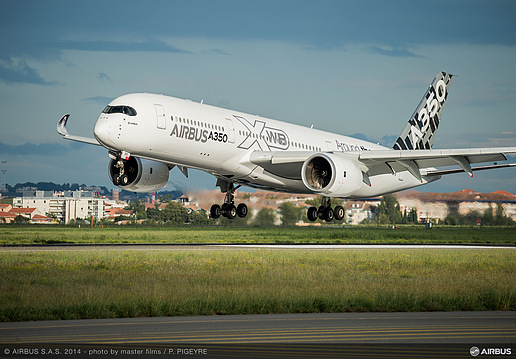 空客公司已用Stratasys FDM 3D生产系统生产了1000多种飞行部件,用于一类A350 XWB机型。
空客公司已用Stratasys FDM 3D生产系统生产了1000多种飞行部件,用于一类A350 XWB机型。 联合发射联盟将用3D打印技术生产即可飞行部件,其中包括Atlas V火箭上的环境控制系统(ECS)导管,搭载新部件的火箭预计将于2016年升空。(ULA)
联合发射联盟将用3D打印技术生产即可飞行部件,其中包括Atlas V火箭上的环境控制系统(ECS)导管,搭载新部件的火箭预计将于2016年升空。(ULA) ULA选择ULTEM 9085作为打印材料,因为它能承受大范围的极限温度。图为Atlas V火箭上3D打印的ECS导管。(ULA)
ULA选择ULTEM 9085作为打印材料,因为它能承受大范围的极限温度。图为Atlas V火箭上3D打印的ECS导管。(ULA)
增材制造(AM)技术正在强势登陆航空航天业生产领域。空客与火箭制造商联合发射联盟(ULA)将在飞行器上使用Stratasys生产的3D打印部件。
这家增材制造方案供应商在今年5月宣布,空客公司已在其Stratasys FDM(熔融沉积成型) 3D生产系统上了生产了1000多个飞行部件,用于2014年12月上市的A350 XWB机型。一名Stratasys发言人表示,空客选择将一些以传统方式生产的轻型或无负载的内饰部件替换成3D打印部件,目的是在达成交货承诺的同时提高供应链的灵活性。
2013年,空客公司与Stratasys联手发起3D打印的开发和认证活动,目的是为了降低生产进度方面的风险。
“只要得到自动化生产所需的数字文件,并具备合格且适当的机器设备,无论你身处哪里都能进行部件的生产,” Stratasys航空航天与防御业务发展经理Scott Sevcik告诉《航空航天工程杂志》。“这意味着研发阶段无需更多考虑制造和采购方面的限制因素,可以依据特定采购要求进行决策,灵活变化,而不需要在整个项目生命周期中固定选择某一项设计。此外,这种生产不需要使用额外的工具,这意味着在改变部件时无需对工具进行相应的变更。要知道修改工具可能耗费数周或数月之久,而且这段时间内还不能进行生产。因此,生产部件的地点和方式变得更加灵活,而更短的修改周期则意味着你可以更自由地掌控改善设计的时间,而且变更所造成的影响也更小。”
这些3D打印部件的原材料是FDM专用的ULTEM 9085树脂,该材料已获得空客公司的材料规范认证。ULTEM 9085热塑材料的强重比极高,而且它的FST(火焰、烟尘和毒性)特性也符合飞机内饰的规范。这一工艺使空客公司不仅能够生产出更轻便的部件,而且还能“大大降低”生产时间和成本。
“此外,因为减少了传统生产方法中不可避免的材料浪费,增材制造还能够显著提高BTF比率(原材料与成品零件之间的重量比),” Stratasys市场推广与垂直解决方案部门事业开发执行副总裁Dan Yalon表示。“Stratasys期待着在与空客的合作中发挥上述及其他优势,并成为空客‘未来工厂计划’的一部分。”
在一个视频中( https://www.youtube.com/watch?v=Cy3V3KR1LWc&feature=youtu.be),空客公司的专家讲解了增材制造将在未来几年内对航空航天业产生怎样的影响。讲解专家在视频中提到,“从长远来看,3D打印将使每一架飞机减少1吨以上的重量。”
ULA使用3D打印技术生产运载火箭的“flight-ready” (意为随时可以升空)部件,生产成本为1.65亿美元,达到了该种部件成本的最低水平。这些部件将用于重达6万磅以上的航天卫星的推进。ULA为NASA、美国空军和商业火箭公司等机构生产运载火箭。
ULA不断推进3D打印技术,从原型机到工具,而现在已进入飞行硬件的生产。在购入Stratasys公司的2台Fortus 900mc 3D生产系统之后,ULA开始更新Atlas V火箭上的环境控制系统(ECS)导管,搭载全新3D部件的火箭预计将于2016年升空。ECS导管负责将氮气输送至火箭助推器的电子部件。
工程师们在使用FDM系统修改设计后,将ECS管道总成的部件从140个合并至16个。ULA表示,这样做大大减少了安装时间,并降低了57%的部件生产成本。
“ULTEM 9085在极宽的温度变化范围内都能保持极高的强度,” ULA增材制造项目经理Greg Arend表示。“我们已经通过测试证明,该材料能承受从低温到高热的温度范围,而且还能承受住升空与飞行产生的振动与压力。”
ULA计划在下一代火箭上将3D打印部件的数量增加至100个以上。
“我们确实能够在很多应用中使用这种高强度热塑材料,因此我们正在将许多金属替换成塑料,要知道塑料的成本要低很多,”ULA材料处理工程师Andrea Casias表示。
“目前的运载火箭上,3D打印的飞行部件的数量正在猛增,”Arend补充道。“而且我们还打算在Vulcan火箭上大量使用3D打印部件。”
航空航天业市场规模较小,但复杂程度极高,是增材制造技术理想的应用领域,Stratasys的Sevcik表示。“2014年初,我们与两家公司讨论过飞行应用材料的认证问题,而现在已经有十多家公司开始关注这一领域。”
Sevcik还提到:“可打印部件的类型是由我们可以提供的材料类型所决定的,目前我们只能打印某些不需要负重的部件,但我们也在与航空航天业的关键客户探讨,如何让该技术走得更远。随着材料和工艺方面的不断改进,我们能实现的应用也越来越多,”其中包括整个飞机和发动机中的结构部件和关键飞行部件。
3D-printed parts fly on Airbus A350 XWB and ULA rockets
Additive manufacturing (AM) is making significant headway in aerospace production programs, as evidenced by recent announcements that Airbus and rocket manufacturer United Launch Alliance (ULA) both are—or soon will be—flying aircraft that incorporate 3D-printed parts enabled by Stratasys.
The AM solutions provider announced in May that Airbus has produced more than 1000 flight parts on its Stratasys FDM (Fused Deposition Modeling) 3D Production Systems for use in the A350 XWB aircraft, delivered in December 2014. Airbus chose to replace certain traditionally manufactured parts—lightly- or non-loaded interior components, according to a Stratasys spokesperson—with the 3D-printed ones in an effort to increase supply chain flexibility, which the company achieved while meeting its delivery commitment.
Airbus initiated development and certification of 3D printing with Stratasys in 2013 as a schedule risk reduction activity.
“With a digital file as the basis for automated production, wherever you have the appropriate, qualified machine to produce the part, you can,” Scott Sevcik, Stratasys’ Aerospace & Defense Business Development Manager, shared withAerospace Engineering. “This shifts the make-buy decision out of the development phase, and can be a decision made based on the needs of the specific procurement rather than a design choice for the life of the program...Also, because you are producing a part without tooling, changes to the part can occur without involving a change to tooling, which can take weeks or months out of the procurement cycle. So you have more flexibility in where and how you produce the parts, and the shorter change cycle enables flexibility to improve designs over time with less impact.”
The parts are 3D-printed using ULTEM 9085 resin for FDM, which is certified to an Airbus material specification. ULTEM 9085 thermoplastic provides high strength-to-weight ratio and is FST (flame, smoke, and toxicity) compliant for aircraft interior applications. The process enables Airbus to manufacture lighter weight parts while “substantially reducing” production time and manufacturing costs.
“Additive manufacturing also greatly improves the buy-to-fly ratio as significantly less material is wasted than with conventional manufacturing methods,” said Dan Yalon, Executive Vice President, Business Development, Marketing & Vertical Solutions for Stratasys. “Stratasys is looking forward to bringing these and other advantages to its collaboration with Airbus and to being part of Airbus’ Factory of the Future initiative.”
Airbus provides insight into how additive manufacturing, in general, will impact its business in the coming years in this video: https://www.youtube.com/watch?v=Cy3V3KR1LWc&feature=youtu.be. The narrator states in the video that “in the long term, 3D printing could reduce weight on each aircraft by more than a ton.”
ULA uses 3D printing to produce flight-ready parts for its launch vehicles, which cost at the lower end about $165 million and are used to propel into space satellites that can weigh more than 60,000 lb. The company makes launch vehicles forNASA, the U.S. Air Force, and commercial satellites.
ULA progressed its use of 3D printing technology from prototyping to tooling and then to flight hardware production. After acquiring two Fortus 900mc 3D Production Systems from Stratasys, the company began updating the environmental control system (ECS) duct on the Atlas V, which is expected to launch with the new 3D component in 2016. The ECS duct delivers nitrogen to electronic components within the rocket booster.
Engineers consolidated the number of parts for the ECS duct assembly from 140 to 16 parts by using FDM technology to modify the design. This “significantly reduces” installation time and results in a 57% part-cost reduction, the company claims.
“ULTEM 9085 has great strength properties over a wide temperature range,” said Greg Arend, Program Manager for Additive Manufacturing at ULA. “We have done testing to show that it is very capable of withstanding temperatures from cryogenic all the way up to extreme heat. And it’s tough enough to handle the vibration and stress of lift off and flight.”
ULA plans to increase the quantity of 3D-printed parts to more than 100 on the next-generation rocket.
“In a lot of cases, because we do have the ability to use this high-strength thermoplastic, we’re actually replacing a lot of metallic applications with plastic applications because it’s substantially less expensive,” said Andrea Casias, Materials Process Engineer at ULA.
“We see somewhat of an exponential growth in the utility of 3D printing for flight applications on our current vehicles,” added Arend. “And we intend to use it heavily with our Vulcan rocket.”
The lower volume, higher complexity nature of the aerospace industry is an ideal fit for additive manufacturing, according to Stratasys’ Sevcik. “In early 2014, we were in discussion with two companies on certifying material for flight applications; today we’re talking to more than 10.
“The type of parts that can be printed will be driven by the type of materials we can offer,” he continued. “Right now, we’re limited to certain applications that aren’t heavily load bearing, but we are working with key customers in the aerospace industry to advance the technology even further. As we continue to improve the material and process offerings, we will be able to address more and more applications,” including structural and flight-critical content throughout the aircraft and engines.
等级
打分
- 2分
- 4分
- 6分
- 8分
- 10分
平均分
